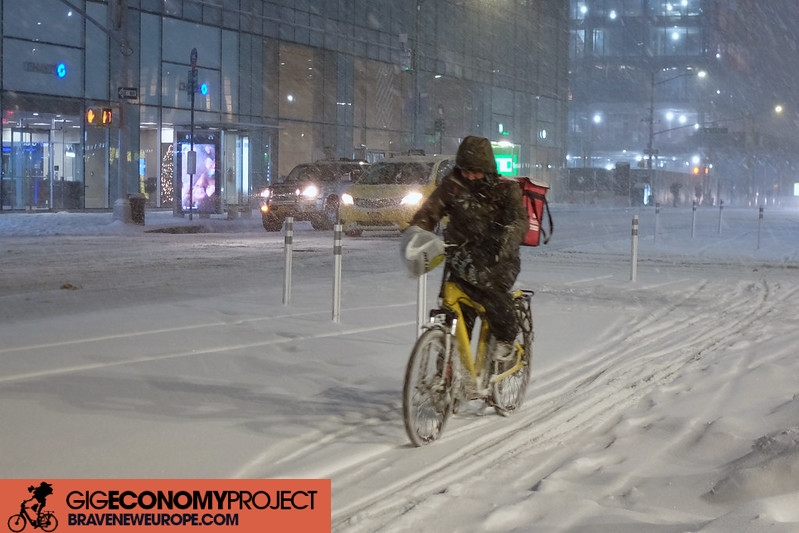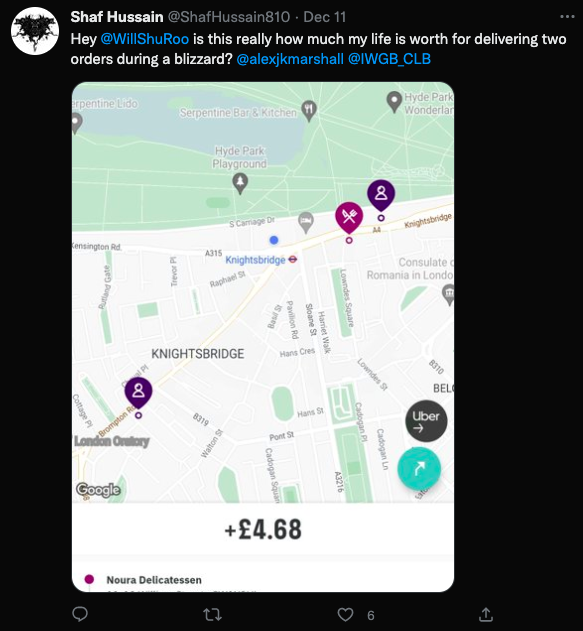Gig Economy Project co-ordinator Ben Wray reports from London where freezing temperatures, snow and ice have made being a food delivery courier an even more dangerous job

YOU don’t have to be in London for long before you see dishevelled looking riders pedalling around the city, hoods up and faces covered, trying to keep out the bitter cold while delivering food to those who don’t want to – and more importantly, don’t have to – bear the weather.
London is going through a cold snap that has seen temperatures drop below zero consistently for about 10 days. Sunday and Monday [11-12 December] brought a blizzard, leaving the British capital covered in snow, which soon turned to ice.
This is danger time for food delivery couriers, who as well as coping with the freezing temperatures, have to be on the look out for slippy spots on the roads.
I’ve been in London for almost a week and have seen many riders – typically with a dirty-looking green Deliveroo back-pack on their back, but I’ve also spotted Uber Eats, Just Eat and GoPuff a few times each – walking with their bike next to them to avoid crashing, or worse.
One of those is Shafi Hussain, a veteran of London’s streets, having been a rider for seven years. He now delivers for both Deliveroo and Uber Eats.
“It’s been brutal,” he tells the Gig Economy Project about riding the past few nights.
“I was out on Sunday night, at first it was okay, just snowing a little bit, and then it just started pouring down with snow. Because you’re riding, you got to deal with the snow coming into your eyes, but on top of that look out for the cars. I had to ditch my bike for the last few deliveries and just walk it to the houses.
“The last time that it snowed, I slipped quite a few times, so now if I do see ice I just get off my bike and walk it. “
Hussain works in another job during the day, so he only rides in the evenings, the most dangerous time in these conditions but also the time where most money can be made. He says he earns less in weather like this, despite demand being higher.
“The platforms are giving a financial boost to incentivise riders to go out, but the boost actually isn’t that great when you consider that we’re losing money because it’s taking longer to do deliveries.

“One of the worst things about it is I don’t get to do all the shortcuts and all the side roads, because they’re covered in ice and snow because no one cleans it. So you have to use all the roads that don’t have ice on them.”
Hussain, who is a member of the IWGB union, believes it is too dangerous for riders to be out in these conditions, but he is an ‘independent contractor’ and will receive nothing if he takes the night off.
“Of course I need to keep working,” he says. “I need to pay for food.”
A 2018 University College of London study on occupational road risk in the gig economy found that 42% of riders say their vehicle had been damaged while working. Ten per cent say someone had been injured in an accident while working, 8% themselves and 2% someone else. Seventy-five per cent agreed or strongly agreed with the statement, ‘there have been occasions while working where I have had to take action to avoid a crash’. “Poor weather conditions” is cited in the report as a key factor in increasing the chances of an accident or fatality, as well as pressure from the algorithm to go faster and being distracted by the app while riding.
The report authors, Dr Nicola Christie and Heather Ward, excoriate the platforms for not providing training to riders on road safety and for offering up financial benefits for riding in dangerous weather.
“There is no risk management by the people who broker courier services,” they write. “These faceless digital brokers take no responsibility for the health and safety of the people who accrue income for them.”
The report calls for improvements such as a proper messaging system between the platform and riders so problems can be communicated, tyres fit for the type of weather riders face, a heated jacket, speed monitoring and a higher general pay rate to reduce incentives for speeding.
READ MORE: “My life is worth more than a sandwich”: Strike in Florence after death of a rider
Suffice to say, four years after this report was published, Hussain – who has been blocked by Deliveroo on Twitter for making complaints – still has none of these things.
“I’ve not received any messages from Deliveroo during this bad weather,” he says. “In the summer, when there was a massive heatwave, they sent out a message saying ‘stay hydrated, look out for your own personal health’. But I’ve received nothing this time.”
He says that in the past the platforms have shutdown their service during extreme weather, but “them shutting down their services means we don’t get paid”.
“So then we end up needing to work harder and risk our lives even more to make up the money we’ve lost,” he adds.
If Hussain was employed, it would be illegal for Deliveroo and Uber Eats to demand he works through extreme weather, proper equipment and clothing provided by the company would be a legal requirement, and they would have to pay workers regardless of whether they can work or not.
“They should have some sort of payment for us when we can’t ride because of the weather, but because we’re self-employed they absolve themselves of any kind of responsibility to us,” he says.
“Of course it would be better if I was employed. I would have much more protection against these kind of things.
“I work for John Lewis and with them, even if I’m sick or ill or late to work because of bad weather conditions, I’m still paid. But as self-employed, if I don’t work I don’t make money.”
As climate breakdown brings more extreme weather, is the job more dangerous than when Hussain started seven years ago?
“Yeah it is,” he answers. “It’s getting hotter or colder depending on the season. But I’m experienced now so I know how to protect myself, others don’t.”
He says that he sees new riders, who have never experienced cold weather like this, out without the proper clothing and with bikes in dire need of proper repairs and puncture-proof tyres.
“They are more in danger of getting injured or even killed,” he says. “They don’t don’t understand how important it is to look after themselves and the bike. And for the guys that are on mopeds or motorcycles, if they slip and fall it’s a really big problem.”
Hussain seems to know his way around this business, but even he had an accident on the road in the winter of 2020, and was out injured for six weeks, with no pay.
“It’s one of my biggest fears to get injured again.”
To sign up to the Gig Economy Project’s weekly newsletter, which provides up-to-date analysis and reports on everything that’s happening in the gig economy in Europe, leave your email here.


Be the first to comment